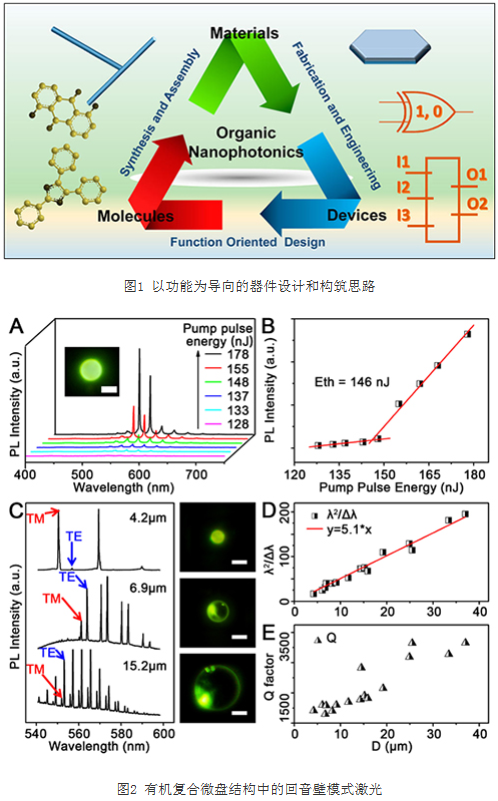
Photonics devices have the advantages of high speed, high bandwidth, and low power consumption that are unmatched by electronic devices. They play a very important role in optical information processing and photonics calculations. Organic light functional molecules are excellent materials for constructing photonics components due to their high fluorescence quantum yield, tailorable optical properties, and flexible processability.
Researchers in the Key Laboratory of the Institute of Chemistry, Institute of Chemistry, Chinese Academy of Sciences have been working on low-dimensional organic photonics materials and devices in recent years (Acc. Chem. Res. 2010, 43, 409-418; Angew. Chem. Int. Ed., 2013, 52, 8713-8717), surrounding micro-nano light sources (J.Am.Chem.Soc.2011, 133, 7276-7279), optical waveguides (Adv. Mater., 2011,23,1380-1384), photonic routers (J.Am.Chem.Soc.2012, 134, 2880-2883), photodetection and sensing (Adv. Mater., 2012, 24, 2332-2336; Adv. Mater., 2012, 24, OP194-OP199), Optical Logic and Wavelength Division Multiplexers (Adv. Mater., 2012, 24, 5681-5686; Adv. Mater., 2013, 25, 2784-2788), Phototransistors (Adv. Mater., 2013, 25, 2854-2859) conducted a series of research work. Relevant work has confirmed the great potential of low-dimensional organic materials in the field of nanophotonics and laid the foundation for further acquisition of photonic elements with complex functions.
The structure and composition of the micro-nano system determine its photonic behavior, and the construction of micro-nano optics with specific functions is of great significance for the integration of photonics. Recently, under the support of the Chinese Academy of Sciences pilot project (Class B), photochemical laboratory researchers have made new progress in the controlled assembly of specific functional organic photonic devices.
Based on the previous work basis, they summarized the relationship between organic molecular interactions, assembly behaviors, aggregation structures, and photonic functions, and then guided by the function, starting from the design synthesis of light functional molecules, and through the controlled assembly of molecules, The design and construction of photonic devices with specific functions have been realized. (FIG. 1) (Chem. Soc. Rev., 2014, 43, 4325-4340, Acc. Chem. Res., 2014, 47, 3448−3458).
Within the boundaries of the closed cavity, light can be trapped inside the cavity to maintain a stable traveling wave transmission mode. In a curved circular or disk-like cavity, light waves can continuously reflect at a curved and smooth cavity wall with little loss. This effect is called the Whispering Gallery Mode (WGM).
The whispering gallery mode optical microcavity has a very high quality factor (Q value), so it can be used in a high quality resonant cavity. With the high optical gain properties of organic dyes, it is expected to achieve high performance micro-nano lasers. Recently, based on an in-depth understanding of the assembly characteristics of organic molecules, the researchers started with the influence of intermolecular interactions on the self-assembly behavior of organic molecules, and used surfactant microemulsions as templates to induce the coordinated assembly of organic polymers and dye molecules. A size-controllable composite microdisk structure was prepared.
The micro-disk structure can be used as a high-quality resonant cavity. Its Q value is up to 104 orders of magnitude, which far exceeds the existing organic cavity structure. They control the micro-disk structure and doping components by controlling the assembly parameters and obtain the mode. Controllable WGM laser (Figure 2). According to the requirements of controllable output in WGM laser applications, the composite structure of microdisks and nanowires was obtained by controlling the phase separation behavior in the assembly process. Using the coupling effect between the line and ring microcavities, a controlled directional output of the WGM laser from the end of the nanowire is achieved.
Roofing Nail --- with an umbrella head
Umbrella head and big head clout wire nails are popularly used in roof construction jobs for attaching felts, slates, wooden sheet, foam sheets and other roofing materials. Supply forms are coiled or bulk loose.
Finishes of roofing screw nails are Stainless steel, Hot Dipped galvanized, electro galvanized, or yellow brass coated.
Roofing Nails,Polished Roofing Nails,Galvanized Roofing Nails,Twist Shank Roofing Nails
HENGSHUI YUZHENG IMPORT AND EXPORT CO., LTD. , https://www.ironnailwiremesh.com